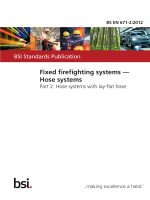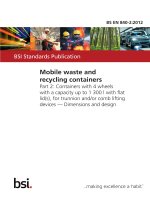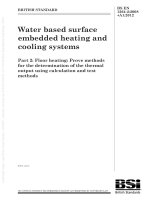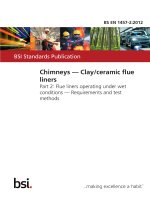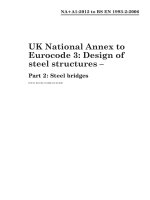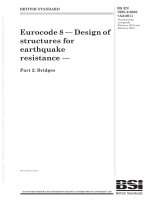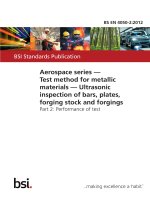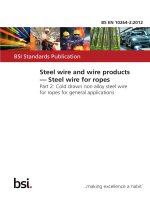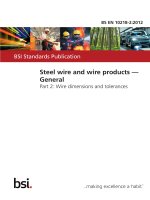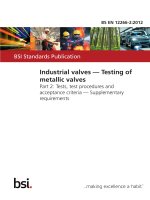Bsi bs en 61010 2 032 2012
Bạn đang xem bản rút gọn của tài liệu. Xem và tải ngay bản đầy đủ của tài liệu tại đây (1.45 MB, 52 trang )
BS EN 61010-2-032:2012
BSI Standards Publication
Safety requirments for
electrical equipment for
measurement, control
and laboratory use
Part 2- 032: Particular requirements
for hand-held and hand-manipulated
current sensors for electrical test and
measurement
BRITISH STANDARD
BS EN 61010-2-032:2012
National foreword
This British Standard is the UK implementation of EN 61010-2-032:2012. It is
identical to IEC 61010-2-032:2012. It supersedes BS EN 61010-2-032:2002
which is withdrawn.
The UK participation in its preparation was entrusted to Technical Committee
EPL/66, Safety of measuring, control and laboratory equipment.
A list of organizations represented on this committee can be obtained on
request to its secretary.
This publication does not purport to include all the necessary provisions of a
contract. Users are responsible for its correct application.
© The British Standards Institution 2012
Published by BSI Standards Limited 2012
ISBN 978 0 580 70871 8
ICS 19.080
Compliance with a British Standard cannot confer immunity from
legal obligations.
This British Standard was published under the authority of the Standards
Policy and Strategy Committee on 31 December 2012.
Amendments issued since publication
Amd. No.
Date
Text affected
BS EN 61010-2-032:2012
EUROPEAN STANDARD
EN 61010-2-032
NORME EUROPÉENNE
November 2012
EUROPÄISCHE NORM
ICS 19.080
Supersedes EN 61010-2-032:2002
English version
Safety requirements for electrical equipment for measurement, control,
and laboratory use Part 2-032: Particular requirements for hand-held and hand-manipulated
current sensors for electrical test and measurement
(IEC 61010-2-032:2012)
Règles de sécurité pour appareils
électriques de mesurage, de régulation et
de laboratoire Partie 2-032: Exigences particulières pour
les capteurs de courant, portatifs et
manipulés à la main, de test et de mesure
électriques
(CEI 61010-2-032:2012)
Sicherheitsbestimmungen für elektrische
Mess-, Steuer-, Regel- und Laborgeräte –
Teil 2-032: Besondere Anforderungen für
handgehaltene und handbediente
Stromsonden für elektrische Prüfungen
und Messungen
(IEC 61010-2-032:2012)
This European Standard was approved by CENELEC on 2012-10-31. CENELEC members are bound to comply
with the CEN/CENELEC Internal Regulations which stipulate the conditions for giving this European Standard
the status of a national standard without any alteration.
Up-to-date lists and bibliographical references concerning such national standards may be obtained on
application to the CEN-CENELEC Management Centre or to any CENELEC member.
This European Standard exists in three official versions (English, French, German). A version in any other
language made by translation under the responsibility of a CENELEC member into its own language and notified
to the CEN-CENELEC Management Centre has the same status as the official versions.
CENELEC members are the national electrotechnical committees of Austria, Belgium, Bulgaria, Croatia, Cyprus,
the Czech Republic, Denmark, Estonia, Finland, Former Yugoslav Republic of Macedonia, France, Germany,
Greece, Hungary, Iceland, Ireland, Italy, Latvia, Lithuania, Luxembourg, Malta, the Netherlands, Norway, Poland,
Portugal, Romania, Slovakia, Slovenia, Spain, Sweden, Switzerland, Turkey and the United Kingdom.
CENELEC
European Committee for Electrotechnical Standardization
Comité Européen de Normalisation Electrotechnique
Europäisches Komitee für Elektrotechnische Normung
Management Centre: Avenue Marnix 17, B - 1000 Brussels
© 2012 CENELEC -
All rights of exploitation in any form and by any means reserved worldwide for CENELEC members.
Ref. No. EN 61010-2-032:2012 E
BS EN 61010-2-032:2012
EN 61010-2-032:2012
-2-
Foreword
The text of document 66/474/FDIS, future edition 3 of IEC 61010-2-032, prepared by IEC/TC 66, "Safety
of measuring, control and laboratory equipment" was submitted to the IEC-CENELEC parallel vote and
approved by CENELEC as EN 61010-2-032:2012.
The following dates are fixed:
•
•
latest date by which the document has
to be implemented at national level by
publication of an identical national
standard or by endorsement
latest date by which the national
standards conflicting with the
document have to be withdrawn
(dop)
2013-07-31
(dow)
2015-10-31
This document supersedes EN 61010-2-032:2002.
EN 61010-2-032:2012 includes the following significant technical changes with respect to EN 61010-2032:2002:
a) A new Type D current sensor has been defined.
b) The terminology for MEASUREMENT CATEGORY I has changed. In this Part 2-032, it is termed “not RATED
for measurements within MEASUREMENT CATEGORIES II, III, or IV”.
c) Requirements for markings of measuring circuit TERMINALS and JAWS have been modified.
d) CLEARANCES and CREEPAGE DISTANCES have been added for unmated measuring circuit TERMINALS.
e) Requirements have been added for specialized measuring circuit TERMINALS.
f) The pull test for endcaps of flexible current sensors has been revised.
g) Requirements for output circuit leads have been revised.
h) Requirements have been added for temperature limits and resistance to heat to prevent thermal
HAZARDS from eddy currents and high currents.
i) Requirements for circuits or components used as TRANSIENT OVERVOLTAGE limiting devices have been
revised.
j) Requirements have been added for low battery indication.
k) Requirements have been revised and added pertaining to REASONABLY FORESEEABLE MISUSE of
measuring circuits, including usage of the current sensor in a manner that might cause arc flash.
l) Requirements for MAINS voltage measuring circuits have been added.
m) Requirements to prevent HAZARDs from short-circuits have been revised and located in a new Clause
102.
n) ROUTINE TESTS have been modified.
o) Insulation requirements for measuring circuits have been primarily located in Annex K.
p) Annex AA has been added to describe the characteristics of MEASUREMENT CATEGORIES.
q) Annex BB has been added to describe HAZARDS that may be encountered when using measuring
circuits.
EN 61010-2-032:2012 is to be used in conjunction with EN 61010-1:2010, on the basis of which It was
established. Consideration may be given to future editions of, or amendments to, EN 61010-1.
This Part 2-032 supplements or modifies the corresponding clauses in EN 61010-1 so as to convert that
publication into the European Standard: Particular requirements for HAND-HELD MULTIMETERS and other
METERS, for domestic and professional use, capable of measuring MAINS voltage.
Where a particular subclause of Part 1 is not mentioned in this Part 2-032, that subclause applies as far
as is reasonable. Where this part states “addition”, “modification”, “replacement”, or “deletion” the relevant
requirement, test specification or note in Part 1 should be adapted accordingly.
In this standard:
a) the following print types are used:
– requirements: in roman type;
-3-
BS EN 61010-2-032:2012
EN 61010-2-032:2012
– NOTES: in small roman type;
– conformity and test: in italic type;
– terms used throughout this standard which have been defined in Clause 3: SMALL ROMAN CAPITALS;
b) subclauses, figures, tables and notes which are additional to those in Part 1 are numbered starting
from 101; and additional list items are numbered from aa). Additional annexes are numbered AA and BB.
Attention is drawn to the possibility that some of the elements of this document may be the subject of
patent rights. CENELEC [and/or CEN] shall not be held responsible for identifying any or all such patent
rights.
This standard covers the Principle Elements of the Safety Objectives for Electrical Equipment Designed
for Use within Certain Voltage Limits (LVD - 2006/95/EC)
Endorsement notice
The text of the International Standard IEC 61010-2-032:2012 was approved by CENELEC as a European
Standard without any modification.
Add the following reference to the bibliography of EN 61010-1:
IEC 61010-2-033
NOTE Harmonized as EN 61010-2-033.
–2–
BS EN 61010-2-032:2012
61010-2-032 © IEC:2012
CONTENTS
INTRODUCTION ..................................................................................................................... 7
1
Scope and object .............................................................................................................. 8
2
Normative references ..................................................................................................... 11
3
Terms and definitions ..................................................................................................... 11
4
Tests .............................................................................................................................. 12
5
Marking and documentation ............................................................................................ 12
6
Protection against electric shock .................................................................................... 16
7
Protection against mechanical HAZARDS .......................................................................... 22
8
Resistance to mechanical stresses ................................................................................. 23
9
8.1 General ................................................................................................................. 23
8.2 E NCLOSURE rigidity tests ........................................................................................ 23
Protection against the spread of fire ............................................................................... 23
10 Equipment temperature limits and resistance to heat ...................................................... 24
11 Protection against HAZARDS from fluids ........................................................................... 24
12 Protection against radiation, including laser sources, and against sonic and
ultrasonic pressure ......................................................................................................... 25
13 Protection against liberated gases and substances, explosion and implosion ................. 25
14 Components and subassemblies .................................................................................... 25
15 Protection by interlocks .................................................................................................. 26
16 H AZARDS resulting from application ................................................................................. 26
17 R ISK assessment ............................................................................................................ 26
101 Measuring circuits .......................................................................................................... 27
102 Prevention of HAZARD from arc flash and short-circuits .................................................... 30
102.1 General ................................................................................................................. 30
102.2 Protection against short-circuits during clamping ................................................... 31
102.3 Protection against short-circuits in closed position ................................................ 32
Annexes ............................................................................................................................... 33
Annex D (normative) Parts between which insulation requirements are specified (see
6.4, 6.5.3, 6.9.101 and 6.9.103) ............................................................................................ 33
Annex F (normative) R OUTINE TESTS .................................................................................... 35
Annex K (normative) Insulation requirements not covered by 6.7 ......................................... 36
Annex L (informative) Index of defined terms ....................................................................... 42
Annex AA (normative) M EASUREMENT CATEGORIES ................................................................ 44
Annex BB (informative) H AZARDS pertaining to measurements performed in certain
environments ........................................................................................................................ 46
Bibliography .......................................................................................................................... 48
Figure 101 – Examples of current sensors and their parts ..................................................... 10
Figure 102 – Pre-treatment of the JAW ENDS .......................................................................... 18
Figure 103 – C LEARANCE between the PROTECTIVE BARRIER or tactile indicator to the
JAWS and to the HAZARDOUS LIVE conductor ........................................................................... 19
Figure 104 – Treatment of the insulation of a flexible current sensor ..................................... 21
BS EN 61010-2-032:2012
61010-2-032 © IEC:2012
–3–
Figure 105 – Pulley for the treatment of Figure 104 .............................................................. 21
Figure 106 – Test probe to check protection against short-circuits ........................................ 31
Figure 107 – Use of the test probe of Figure 106 .................................................................. 32
Figure D.101 – Parts of current sensors (see also Table D.101) ............................................ 33
Figure AA.1 – Example to identify the locations of measuring circuits ................................... 45
Table 101 – C LEARANCES and CREEPAGE DISTANCES for measuring circuit TERMINALS
with HAZARDOUS LIVE conductive parts ................................................................................... 17
Table 102 – Pull forces for endcaps of flexible current sensors ............................................. 22
Table 103 – Energy level ...................................................................................................... 23
Table 104 – Impulse voltages ............................................................................................... 26
Table 105 – Thickness of the test probe of Figure 106 and test voltages............................... 32
Table D.101 – Insulation requirements between circuits and ACCESSIBLE parts of
current sensors ..................................................................................................................... 34
Table F.101 – Test voltages for ROUTINE TESTS of JAWS of current sensors ............................ 35
Table K.101 – C LEARANCES for measuring circuits of MEASUREMENT CATEGORIES II, III
and IV ................................................................................................................................... 37
Table K.102 – Test voltages for testing electric strength of solid insulation in
measuring circuits of MEASUREMENT CATEGORY II ................................................................... 38
Table K.103 – Test voltages for testing electric strength of solid insulation in
measuring circuits of MEASUREMENT CATEGORY III .................................................................. 38
Table K.104 – Test voltages for testing electric strength of solid insulation in
measuring circuits of MEASUREMENT CATEGORY IV .................................................................. 39
Table K.105 – Test voltages for testing long term stress of solid insulation in
measuring circuits ................................................................................................................. 39
Table AA.1 – Characteristics of MEASUREMENT CATEGORIES ................................................... 45
BS EN 61010-2-032:2012
61010-2-032 © IEC:2012
–7–
INTRODUCTION
IEC 61010-1 specifies the safety requirements that are generally applicable to all equipment
within its scope. For certain types of equipment, the requirements of IEC 61010-1 will be
supplemented or modified by the special requirements of one, or more than one, particular
part 2s of the standard which are to be read in conjunction with the Part 1 requirements.
This Part 2-032 specifies the safety requirements that are generally applicable to HAND - HELD
and hand-manipulated current sensors (see Clause 1).
Part 2-030 specifies the safety requirements for testing and measuring circuits which are
connected for test or measurement purposes to devices or circuits outside the measurement
equipment itself.
Part 2-033 specifies the safety requirements for HAND HELD METERS that have a primary
purpose of measuring voltage on a live MAINS CIRCUIT .
Except for protective bonding, all requirements of Part 2-030 have been included into
Part 2-032. Equipment within the scopes of Part 2-030 and Part 2-032 are considered to be
covered by the requirements of Part 2-032. However, for equipment within the scope of both
Part 2-032 and Part 2-033, the two standards are to be read in conjunction.
–8–
BS EN 61010-2-032:2012
61010-2-032 © IEC:2012
SAFETY REQUIREMENTS FOR ELECTRICAL EQUIPMENT
FOR MEASUREMENT, CONTROL AND LABORATORY USE –
Part 2-032: Particular requirements for hand-held and
hand-manipulated current sensors for electrical test and measurement
1
Scope and object
This clause of Part 1 is applicable except as follows:
1.1.1
Equipment included in scope
Replacement:
Replace the existing text with the following:
This part of IEC 61010 specifies safety requirements for HAND - HELD and hand-manipulated
current sensors described below.
These current sensors are for measuring, detecting or injecting current, or indicating current
waveforms on circuits without physically opening the current path of the circuit being
measured. They may be stand-alone current sensors or accessories to other equipment or
parts of combined equipment (see Figure 101). These include measurement circuits which are
part of electrical test and measurement equipment, laboratory equipment, or process control
equipment. The existence of these current sensors and circuits in equipment requires
additional protective means between the current sensor, the circuit and an OPERATOR .
NOTE 1 This part includes also the requirements of Part 2-030. Testing and measuring circuits that are not within
the scope of this part are considered to be covered by the requirements of Part 1 or other parts 2s of IEC 61010,
and then will also need to meet the requirements of these other parts with the exception of Part 2-030. Current
clamp meters and similar currents sensors that have a primary purpose of measuring voltage on a live MAINS
CIRCUIT are also within the scope of Part 2-033.
NOTE 2
Some current sensors are also known as current clamps and current probes.
Current sensors require hand manipulation before or after a test or measurement, but do not
necessarily need to be HAND - HELD during the test or measurement.
NOTE 3
Some current sensors designed for portable use can also be used for fixed installations.
The following types of current sensors are covered:
a) Type A: a current sensor designed to be applied around or removed from UNINSULATED
HAZARDOUS LIVE conductors. Type A current sensors have defined HAND - HELD or handmanipulated parts providing protection against electric shock from the conductor being
measured, and also have protection against short-circuits between wires and busbars
during clamping.
b) Type B: a current sensor which has protection against short-circuits between wires or
busbars during clamping but without defined HAND - HELD or hand-manipulated parts which
provide protection against electric shock during clamping. Additional protective means are
necessary to avoid electric shock from HAZARDOUS LIVE conductors which cannot be deenergised during application or removal of the current sensor.
EXAMPLE 1
Flexible current sensors.
c) Type C: a current sensor without protection against short-circuits between wires or
busbars during clamping. Type C current sensors are intended to be applied to or removed
BS EN 61010-2-032:2012
61010-2-032 © IEC:2012
–9–
from UNINSULATED HAZARDOUS LIVE conductors
conductors only when they are de-energised.
EXAMPLE 2
or
from
non-limited-energy
circuit
Split-core transducers.
d) Type D: a current sensor designed to be applied around or removed from insulated
conductors or from limited-energy circuit conductors.
A Type D current sensor does not need protection against short-circuits during clamping
and has no defined HAND - HELD or hand-manipulated parts providing protection against
electric shock from the conductor being measured.
EXAMPLE 3
Current probes for oscilloscopes and earth leakage current detectors.
NOTE 4 All current sensors can also be used around insulated conductors. In this case, HAZARDS are limited to
acceptable levels by the insulation of the conductors.
– 10 –
61010-2-032 © IEC:2012
1
3
0,00 A
1
3
2
2
Type A
Type A
Current sensor as an accessory
Current sensor with self-contained measuring functions
or with additional measuring functions
1
2
1
2
Type B
Type C
Flexible current sensor
Split-core current sensor
1
2
Type D
IEC 1865/12
Current sensor for non HAZARDOUS LIVE applications
(shown with a sliding JAW )
Key
1
JAW END ( S )
2
JAW
3
measuring circuit TERMINALS
Figure 101 – Examples of current sensors and their parts
1.2.1
Aspects included in scope
Addition:
Add the following two new paragraphs at the end of the subclause:
Requirements for protection against HAZARDS resulting from NORMAL USE and REASONABLY
FORESEEABLE MISUSE of measuring circuits are given in Clause 101.
BS EN 61010-2-032:2012
61010-2-032 © IEC:2012
– 11 –
Requirements for prevention of HAZARD from arc flash and short-circuits are given in
Clause 102.
2
Normative references
This clause of Part 1 is applicable.
3
Terms and definitions
This clause of Part 1 is applicable except as follows:
3.1
Equipment and states of equipment
Addition:
Add the following new definition:
3.1.101
HAND - HELD
intended to be supported by one hand during NORMAL USE
3.2
Parts and accessories
Addition:
Add the following new definitions:
3.2.101
JAW
part of a current sensor which surrounds or partially surrounds the conductor under test
3.2.102
JAW END
part of the JAW where opening occurs while clamping around a conductor
3.5
Safety terms
Replacement:
Replace the definitions of 3.5.4 and 3.5.5 with the following new definitions:
3.5.4
MAINS
low-voltage electricity supply system to which the current sensor concerned is designed to be
connected for the purpose of powering the current sensor or for measurements
3.5.5
MAINS CIRCUIT
circuit which is intended to be directly connected to the MAINS for the purpose of powering the
current sensor or for measurements
– 12 –
BS EN 61010-2-032:2012
61010-2-032 © IEC:2012
Addition:
Add the following new definition:
3.5.101
MEASUREMENT CATEGORY
classification of testing and measuring circuits according to the type of MAINS CIRCUITS to
which they are intended to be connected
Note 1 to entry: M EASUREMENT CATEGORIES take into account OVERVOLTAGE CATEGORIES , short-circuit current
levels, the location in the building installation at which the test or measurement is to be made and some forms of
energy limitation or transient protection included in the building installation. See Annex AA for more information.
3.6
Insulation
Addition:
Add the following new definition:
3.6.101
UNINSULATED
not insulated by solid insulation or insulated by solid insulation which does not meet the
requirements for BASIC INSULATION for the relevant voltage to earth
4
Tests
This clause of Part 1 is applicable except as follows:
4.4.2.8
Outputs
Replacement:
Replace the text with the following:
Outputs shall be open-circuited and short-circuited, one at a time.
5
Marking and documentation
This clause of Part 1 is applicable except as follows:
5.1.2
Identification
Addition:
Add the following new items and a new paragraph after the note to item b):
aa)
for current sensors designed for use only with a specific model of equipment, a clear
identification of the equipment, or with symbol 14 of Table 1 if this information is
available only in the documentation;
bb)
for Type A current sensors, with symbol 102 of Table 1;
cc)
for Type B and Type C current sensors, with symbol 101 of Table 1;
dd)
for Type D current sensors, symbol 101 of Table 1 is permitted with an additional
marking (see 5.1.5.102).
The relevant symbol (14, 101 or 102) shall be marked adjacent to the JAWS or the marking of
the MEASUREMENT CATEGORY for the JAWS , if present (see 5.1.5.101 and 5.1.5.102).
61010-2-032 © IEC:2012
– 13 –
Table 1 – Symbols
Addition:
Add the following new symbols:
Number
Symbol
Reference
Description
Do not apply around or
remove from UNINSULATED
HAZARDOUS LIVE
101
conductors, which may
render electric shock,
electric burn, or arc flash
Application around and
removal from UNINSULATED
102
HAZARDOUS LIVE
conductors is permitted
5.1.5
T ERMINALS , connections and operating devices
Addition:
Add the following new subclauses:
5.1.5.101
Measuring circuit TERMINALS
5.1.5.101.1
General
Except as permitted in 5.1.5.101.4:
a) the value of the RATED voltage to earth of measuring circuit TERMINALS shall be marked,
and
b) the value of the RATED voltage or the RATED current, as applicable, of each pair or set of
measuring circuit TERMINALS that are intended to be used together shall be marked, and
c) the pertinent MEASUREMENT CATEGORY for each individual, pair, or set of measuring circuit
TERMINALS or symbol 14 of Table 1 shall be marked as specified in 5.1.5.101.2 and
5.1.5.101.3, if applicable.
Measuring circuit TERMINALS are usually arranged in pairs or sets. Each pair or set of
TERMINALS may have a RATED voltage or a RATED current, or both, within that set, and each
individual TERMINAL may have a RATED voltage to earth. For some equipment, the RATED
voltage between TERMINALS may be different from the RATED voltage to earth. Markings shall
be clear to avoid misunderstanding.
Markings shall be placed adjacent to the TERMINALS . However, if there is insufficient space (as
in multi-input equipment), the marking may be on the RATING plate or scale plate, or the
TERMINAL may be marked with symbol 14 of Table 1.
For any set of measuring circuit TERMINALS , symbol 14 of Table 1 does not need to be marked
more than once, if it is close to the TERMINALS .
Conformity is checked by inspection and, if applicable, as specified in 5.1.5.101.2 and
5.1.5.101.3, taking the exceptions in 5.1.5.101.4 into account.
– 14 –
5.1.5.101.2
BS EN 61010-2-032:2012
61010-2-032 © IEC:2012
Measuring circuit TERMINALS RATED for MEASUREMENT CATEGORIES II, III or IV
The relevant MEASUREMENT CATEGORY shall be marked for measuring circuit TERMINALS RATED
for measurements within MEASUREMENT CATEGORIES II, III or IV. The MEASUREMENT CATEGORY
markings shall be “CAT II”, “CAT III” or “CAT IV” as applicable.
Marking more than one type of MEASUREMENT CATEGORY and its RATED voltage to earth is
permissible (see also 5.1.5.101.1).
Conformity is checked by inspection.
5.1.5.101.3
Measuring circuit TERMINALS RATED for connection to voltages above the
levels of 6.3.1
Symbol 14 of Table 1 shall be marked for measuring circuit TERMINALS RATED for connection to
voltages above the levels of 6.3.1, but that are not RATED for measurements within
MEASUREMENT CATEGORIES II, III or IV (see also 5.4.2 bb)).
Conformity is checked by inspection.
5.1.5.101.4
Low voltage, permanently connected, or dedicated measuring circuit
TERMINALS
Measuring circuit TERMINALS do not need to be marked if:
a) they are intended to be permanently connected and not ACCESSIBLE (see 5.4.3 aa)
and bb)), or
b) they are dedicated only for connection to specific TERMINALS of other equipment, or
c) it is obvious from other indications that the RATED voltage is below the levels of 6.3.1.
NOTE Examples of acceptable indications that the inputs are intended to be less than the levels of 6.3.1
include:
–
the full scale deflection marking of a single-range indicating voltmeter or ammeter;
–
the maximum range marking of a voltage selector switch;
–
a marked voltage or power RATING expressed in dB, mW or W, where the equivalent value, as explained in
the documentation, is below 33 V a.c.
Conformity is checked by inspection.
5.1.5.102
Voltage and current RATINGS of JAWS
Current sensors that are intended to be used on UNINSULATED conductors shall be marked
with the value of the RATED voltage to earth of the JAWS .
Current sensors that are intended to be used only on insulated conductors shall be marked to
indicate that the current sensor must not be used on UNINSULATED conductors, or with
symbol 14.
J AWS of Type A, Type B or Type C current sensors RATED for measurements within
MEASUREMENT CATEGORIES II, III or IV, shall be marked with the relevant MEASUREMENT
CATEGORY adjacent to the voltage to earth marking. The MEASUREMENT CATEGORY markings
shall be “CAT II”, “CAT III” or “CAT IV” as applicable.
J AWS and output circuit TERMINALS of Type D current sensors shall not be marked with any
MEASUREMENT CATEGORY .
The value of the RATED current shall be marked. The nature of the current shall also be
marked unless the marked value applies to both a.c. and d.c. current.
BS EN 61010-2-032:2012
61010-2-032 © IEC:2012
– 15 –
Conformity is checked by inspection.
5.4.2
Equipment RATINGS
Addition:
Add the following two new items to the list and a new paragraph:
aa)
information about each relevant MEASUREMENT CATEGORY if the measuring circuit has a
RATING for MEASUREMENT CATEGORY II, III or IV (see 5.1.5.101.2 and 5.1.5.102);
bb)
for current sensors that do not have a RATING for MEASUREMENT CATEGORY II, III or IV,
but could be misused by connection to such circuits, a warning not to use the current
sensor for measurements on MAINS CIRCUITS , and a detailed RATING including TRANSIENT
OVERVOLTAGES (see AA.2.4 for more information).
If the current sensor has multiple MEASUREMENT CATEGORY RATINGS for the same measuring
circuit, the documentation shall clearly identify the MEASUREMENT CATEGORIES where the
current sensor is intended to be used and where it must not be used.
5.4.3
Equipment installation
Addition:
Add the following two new items to the list:
aa)
for measuring circuit TERMINALS intended for permanent connection and RATED for
MEASUREMENT CATEGORIES II, III or IV, information regarding the MEASUREMENT
CATEGORY , RATED voltages or RATED currents as applicable (see 5.1.5.101 and
5.1.5.102);
bb)
for measuring circuit TERMINALS intended for permanent connection and that are not
for MEASUREMENT CATEGORIES II, III or IV, information regarding the RATED
voltages, RATED currents, and RATED TRANSIENT OVERVOLTAGES as applicable (see
5.1.5.101 and 5.1.5.102).
RATED
5.4.4
Equipment operation
Replacement:
Replace the existing text with the following:
Instructions for use shall include, if applicable:
a) identification and description of operating controls and their use in all operating modes;
b) for current sensors designed for use only with a specific model of equipment, a clear
identification of the equipment;
c) specifications of limits for intermittent operation;
d) specifications of limits of the current versus the frequency if the magnetic circuit can reach
a hazardous temperature;
e) explanations of symbols related to safety which are used on the equipment;
f)
instructions for interconnection to accessories and other equipment, including indication of
suitable accessories and detachable parts;
g) instructions for replacement of consumable materials;
h) instructions for cleaning and decontamination;
i)
instructions for the application and removal of the current sensor;
– 16 –
j)
BS EN 61010-2-032:2012
61010-2-032 © IEC:2012
instructions to de-energise the installation on which the current is measured, or to adopt
safe operating procedures when working on HAZARDOUS LIVE installations, during
application and removal of Type B current sensors;
k) instructions to de-energise the installation on which the current is measured, when
working on HAZARDOUS LIVE installations, or non-limited-energy installations during
application and removal of Type C current sensors;
l)
instructions about the function of the tactile indicator or PROTECTIVE BARRIER , indicating the
limit of safe access of the HAND - HELD part;
m) a warning to the OPERATOR that Type D current sensors are only for use around insulated
conductors or limited energy circuit conductors;
n) a warning to the OPERATOR that individual protective equipment should be used if
HAZARDOUS LIVE parts in the installation where measurement is to be carried out could be
ACCESSIBLE ;
o) a warning to the OPERATOR not to use a flexible current sensor if the wear indicator of the
flexible cord used for the JAW of the flexible current sensor is visible (see 6.9.101.4);
p) a warning to the OPERATOR not to use a current sensor if the wear indicator in the JAW END
is visible (see 6.9.101.3);
q) a warning to the OPERATOR not to use a current sensor above its RATED frequency, if the
magnetic circuit can reach a hazardous temperature (see 10.101).
There shall be a statement in the instructions that, if the current sensor is used in a manner
not specified by the manufacturer, the protection provided by the current sensor may be
impaired.
Conformity is checked by inspection.
6
Protection against electric shock
This clause of Part 1 is applicable except as follows:
6.1.2
Exceptions
Addition:
Add the following new item aa):
aa) conductive parts of a JAW END , provided that they meet the requirements of 6.9.101.
6.5.2
P ROTECTIVE BONDING
Replacement:
Replace the title and text with:
6.5.2
6.6
(Void)
Connections to external circuits
Addition:
Add the following new subclauses:
6.6.101
Measuring circuit TERMINALS
Conductive parts of each unmated measuring circuit TERMINAL which could become
when the highest RATED voltage is applied to other measuring circuit
HAZARDOUS LIVE
BS EN 61010-2-032:2012
61010-2-032 © IEC:2012
TERMINALS on the equipment
CREEPAGE DISTANCE of Table
external parts of the TERMINAL
– 17 –
shall be separated by at least the applicable CLEARANCE and
101 from the closest approach of the test finger touching the
in the least favourable position (see Figure 1).
Table 101 – C LEARANCES and CREEPAGE DISTANCES for measuring
circuit TERMINALS with HAZARDOUS LIVE conductive parts
Voltage on conductive parts of TERMINAL
C LEARANCE and
CREEPAGE DISTANCE
V a.c. r.m.s.
V d.c.
mm
≥ 33 ≤ 300
≥ 70 ≤ 414
0,8
> 300 ≤ 600
> 414 ≤ 848
1,0
> 600 ≤ 1 000
> 848 ≤ 1 414
2,6
NOTE For W ET LOCATIONS , there are no CLEARANCE and CREEPAGE
DISTANCE requirements for voltages between 16 V a.c. r.m.s. and 33 V
a.c. r.m.s., or between 35 V d.c. and 70 V d.c., but conductive parts of
unmated measuring circuit TERMINALS shall not be ACCESSIBLE . The values
in this table are not applicable to voltages below HAZARDOUS LIVE voltages
(see 6.3.1 a) ).
Conformity is checked by inspection and measurement.
6.6.102
Specialized measuring circuit TERMINALS
Components, sensors, and devices intended to be connected to specialized measuring circuit
TERMINALS shall not be both ACCESSIBLE and HAZARDOUS LIVE , in either NORMAL CONDITION or
SINGLE - FAULT CONDITION , even when the highest RATED voltage is applied to any other
measuring circuit TERMINAL .
NOTE These specialized TERMINALS include, but are not limited to, TERMINALS for semiconductor measuring
functions, capacitance measurements, and thermocouple sockets.
Conformity is checked by inspection and measurement. Components, sensors, and devices
intended to be connected to specialized measuring circuit TERMINALS are connected. The
measurements of 6.3 are made to establish that the levels of 6.3.1 and 6.3.2 are not
exceeded when each of the following voltages is applied to each other measuring circuit
TERMINAL , if applicable:
a) highest RATED a.c. voltage at any RATED MAINS frequency;
b) highest RATED d.c. voltage;
c) highest RATED a.c. voltage at the maximum RATED measurement frequency.
6.7.1.5
Requirements for insulation according to type of circuit
Addition:
Add the following new item ci) after item v) of the list of item e)
ci)
the circuit is a measuring circuit where MEASUREMENT CATEGORIES do not apply.
Add the following new item aa) to the list:
aa) in K.101 for measuring circuits of MEASUREMENT CATEGORIES II, III and IV.
BS EN 61010-2-032:2012
61010-2-032 © IEC:2012
– 18 –
Replacement:
Replace Note 2 with the following:
NOTE 2
6.9
(Void)
Constructional requirements for protection against electric shock
Addition:
Add the following new subclauses:
6.9.101
Insulation requirements for JAWS and JAW ENDS
6.9.101.1
Pre-treatment of the JAW ENDS
This pre-treatment shall be performed only for Type A and Type B current sensors RATED for
MEASUREMENT CATEGORIES III and IV.
The pre-treatment is performed to simulate the wear of the JAWS during insertion and removal.
It is not applicable to current sensors with a sliding JAW and to flexible current sensors.
Three samples of the current sensor in NORMAL CONDITION and three samples of the current
sensor that have been conditioned as specified in 10.5.2 a) are treated as follows.
A pre-treatment plate is prepared consisting of a rigid material, covered on both sides by
emery cloth. The pre-treatment plate is a minimum of 50 mm by 450 mm, with a thickness not
exceeding 2 mm. The emery cloth shall be No. 120 grit, with aluminium oxide abrasive bound
in an enclosed coating and with a cloth backing.
With the JAWS open, the current sensor is positioned as shown in Figure 102 and then the
JAWS are closed.
The current sensor is moved along the pre-treatment plate a distance of 200 mm, or a lesser
amount if restricted by the design, for 50 cycles – one cycle consisting of one forward and one
reverse movement – so as to abrade the closing point of the JAWS (see Figure 102). If the
insulation of the JAW ENDS has a wear indicator, the treatment is terminated if the wear
indicator becomes visible before 50 cycles are completed. The emery cloth is replaced after
each sample has been treated.
NOTE With regard to JAW ENDS , a wear indicator is a feature designed to be not visible until a limit of wear has
been reached.
200 mm
IEC 1866/12
Figure 102 – Pre-treatment of the JAW ENDS
6.9.101.2
Protection against touching the HAZARDOUS LIVE conductor
To reduce the DANGER of the OPERATOR touching the HAZARDOUS LIVE conductor during
clamping or measurement, Type A current sensors shall have a PROTECTIVE BARRIER or tactile
indicator to warn the OPERATOR of the limit of safe access. The tactile indicator shall cover at
least 50 % of the perimeter, and shall at least extend along two opposite sides of the HAND HELD part.
BS EN 61010-2-032:2012
61010-2-032 © IEC:2012
– 19 –
The CLEARANCE and CREEPAGE DISTANCE between HAZARDOUS LIVE parts and the PROTECTIVE
BARRIER or the tactile indicator shall meet the requirements for REINFORCED INSULATION for the
RATING of the JAWS . Figure 103 gives an example of the CLEARANCE “d” from the PROTECTIVE
BARRIER or tactile indicator to the JAWS and to the HAZARDOUS LIVE conductor.
Conformity is checked by inspection and measurement of CLEARANCES and CREEPAGE
DISTANCES .
d
1
2
IEC 1867/12
Key
1
H AZARDOUS LIVE conductor
2
P ROTECTIVE BARRIER
d
Distance between PROTECTIVE BARRIER and HAZARDOUS LIVE conductor
Figure 103 – C LEARANCE between the PROTECTIVE BARRIER or tactile indicator
to the JAWS and to the HAZARDOUS LIVE conductor
6.9.101.3
H AND - HELD or hand-manipulated parts
H AND - HELD or hand-manipulated parts of Type A current sensors shall be separated by
DOUBLE INSULATION or REINFORCED INSULATION from the parts of the JAWS which can be touched
by a metal test pin 100 mm long and 4 mm in diameter, in open and in closed position. If any
conductive part of the magnetic circuit can touch a conductor, it is considered to be held at
the RATED voltage to earth of the JAWS .
NOTE
The metal test pin simulates an UNINSULATED conductor.
If the wear indicator of a JAW END becomes visible during the pre-treatment, BASIC INSULATION
is required for the JAW END after the pre-treatment.
Conformity is checked by inspection, by the determination of ACCESSIBLE parts according to
6.2, by measurement of CLEARANCES and CREEPAGE DISTANCES and by the tests of K.101.4 for
solid insulation. If the JAW ENDS include a wear indicator, measurement and tests are done
both before and after the pre-treatment of the JAW ENDS specified in 6.9.101.1, if applicable. If
the JAW ENDS do not include a wear indicator, measurement and tests are performed after the
pre-treatment.
6.9.101.4
Insulation of flexible current sensors
Flexible cord used for the JAW of a flexible current sensor which has a wear indicator shall
provide at least DOUBLE INSULATION or REINFORCED INSULATION when new, and at least BASIC
INSULATION when the wear indicator is visible.
– 20 –
BS EN 61010-2-032:2012
61010-2-032 © IEC:2012
If the flexible cord has a wear indicator, it shall exhibit a contrasting colour when the limit of
wear is reached.
Flexible cord used for the JAW of a flexible current sensor which does not have a wear
indicator shall provide at least DOUBLE INSULATION or REINFORCED INSULATION when new and
after typical lifetime wear.
Conformity is checked by the following tests:
Three unconditioned samples of the flexible cord used for the JAW of the flexible current
sensor and three samples conditioned as specified in 10.5.2 a) are tested. Each sample is
1 m long.
One unconditioned sample is checked as specified by K.101.4, with the values for REINFORCED
INSULATION .
Each sample is passed over a piece of emery cloth mounted to and conforming with the pulley
radius of curvature (see Figure 105), with the pulley fixed so that it cannot rotate
(see Figure 104). The internal pulley diameter and the pulley radius of curvature are at least 5
times the cord diameter. The emery cloth shall be No. 120 grit, with aluminium oxide abrasive
bound in an enclosed coating and a cloth backing. It shall be of sufficient length and width so
that the sample makes contact with the emery cloth wherever it would otherwise contact the
pulley surface. The emery cloth is replaced after each sample is treated. To prevent rolling of
the flexible cord, the inside surface of the pulley is concave.
The flexible cord is placed over the pulley (see Figure 104) and supported by a 90° arc of the
pulley. One end of the flexible cord is attached to a weight with a mass of 1 kg. The flexible
cord is positioned so that its midpoint is at the centre of the emery cloth at the middle of the
cycle. With the weight guided to prevent swinging, the flexible cord is passed over the emery
cloth surface for the lesser of 15 cycles or until a wear indicator becomes visible – one cycle
consisting of one forward and one reverse movement of the free end of the cord for a distance
of 0,5 m.
After this treatment, each sample is checked as specified by K.101.4. The voltage is applied
between the internal conductors of the flexible cord and metal foil wrapped around the outer
cord jacket. The BASIC INSULATION test voltage values are used if the cycling treatment was
terminated because the contrasting colour became visible. The REINFORCED INSULATION test
voltage values are used if 15 cycles were completed during the cycling treatment without the
wear indicator becoming visible.
61010-2-032 © IEC:2012
– 21 –
2
1
3
4
IEC 1868/12
Key
1 Flexible cord
3 Weight
2 Fixed pulley
4 Weight guide
Figure 104 – Treatment of the insulation of a flexible current sensor
2
1
IEC 1869/12
Key
1
Internal pulley diameter
2
Pulley radius of curvature
Figure 105 – Pulley for the treatment of Figure 104
6.9.101.5
Pull test for endcaps of flexible current sensors
The endcaps of a flexible cord used for the JAW of the flexible current sensor shall be securely
fixed, so that they withstand any forces likely to occur in NORMAL USE .
Conformity is checked by inspection and the following test on each endcap.
With the endcap clamped so that it cannot move, the flexible cord is subjected to a steady
axial pull force according to Table 102 for 1 min.
After the pull the insulation shall not have moved more than 2 mm.
BS EN 61010-2-032:2012
61010-2-032 © IEC:2012
– 22 –
If the insulation has moved more than 2 mm, then the pull is repeated 15 more times with a
duration of 15 s each.
After the last pull:
a) the insulation shall not have moved more than 1 mm more than the displacement from the
first pull if it is subjected to 16 pulls;
b) CLEARANCES and CREEPAGE DISTANCES shall not have been reduced below the applicable
values of K.101 for REINFORCED INSULATION ; and
c) the current sensor shall pass the tests of K.101.4 for REINFORCED INSULATION .
Table 102 – Pull forces for endcaps of flexible current sensors
Cross section area of the
flexible cord
Pull force
mm 2
N
≤ 25
50
100
75
≥ 500
100
Linear interpolation is allowed.
6.9.102
Input measuring circuit leads
Input measuring circuit leads and their accessories shall meet the requirements of IEC 61010031, if applicable.
Conformity is checked by inspection.
6.9.103
Output circuit leads
The output circuit leads of current sensors can easily touch HAZARDOUS LIVE parts of the
installation under test. The output circuits of current sensors can also be held at a HAZARDOUS
LIVE voltage when connected to a wattmeter, power quality analyser or similar equipment.
The output circuit leads of current sensors shall have REINFORCED INSULATION between their
outer surfaces and their conductors.
The mated connectors and TERMINALS located at the current sensor ENCLOSURE body shall
have REINFORCED INSULATION between their outer surfaces and their conductors.
For Type A, Type B and Type C current sensors, the insulation of the output circuit leads, and
of the mated connectors and TERMINALS is based on the requirements of K.101 for the higher
of the voltage RATING and the MEASUREMENT CATEGORY RATING of the JAWS or those RATINGS of
the output circuit but not less than 300 V in MEASUREMENT CATEGORY II.
For Type D current sensors, the insulation of the output circuit leads and of the mated
connectors and TERMINALS is based on the requirements of K.101 for 300 V in MEASUREMENT
CATEGORY II.
Conformity is checked by inspection, by measurement of CLEARANCES and CREEPAGE
and by the applicable tests of K.101.4 for solid insulation.
DISTANCES
7
Protection against mechanical HAZARDS
This clause of Part 1 is applicable.
BS EN 61010-2-032:2012
61010-2-032 © IEC:2012
8
– 23 –
Resistance to mechanical stresses
This clause of Part 1 is applicable except as follows:
8.1
General
Addition:
Add the following new item 101), after item 3):
101)
8.2
for Type A current sensors RATED for MEASUREMENT CATEGORIES III and IV, the impact
test of 8.2.101.
E NCLOSURE rigidity tests
Addition:
Add the following new subclause:
8.2.101
J AW impact test
The test is carried out on three samples of Type A current sensors RATED for MEASUREMENT
CATEGORIES III and IV.
The current sensor is tested according to IEC 60068-2-75 by either test Eha (pendulum
hammer) or test Ehc (vertical hammer) with an energy level of Table 103.
Table 103 – Energy level
Current sensor mass
kg
Energy level
J
IK Code
(IEC 62262)
≤ 0,5
1
IK06
> 0,5 ≤ 1
2
IK07
>1
5
IK08
Current sensors are cooled to the minimum RATED ambient temperature, and then tested
within 3 min. The current sensor is held firmly against a rigid support and opened as far as
possible. Three points on the outer surfaces of the JAWS close to the JAW ENDS are tested on
each sample. The number of impacts is one per point.
After the impact test, the current sensors are returned to a reference test temperature
(see 4.3.1). For each voltage of Table 105 up to and including the highest RATED voltage of
the JAWS , the specified test probe of Figure 106 and Table 105 is inserted into the JAW
opening as shown in Figure 107. While each test probe is inserted, the current sensor shall
pass the a.c. voltage test of 6.8.3.1 (without humidity preconditioning) with a duration of at
least 1 min, or for current sensors RATED only for d.c., the 1 min d.c. voltage test of 6.8.3.2
(without humidity preconditioning), using the applicable test voltage of Table 105 applied
between the test lead wires.
9
Protection against the spread of fire
This clause of Part 1 is applicable.
– 24 –
BS EN 61010-2-032:2012
61010-2-032 © IEC:2012
10 Equipment temperature limits and resistance to heat
This clause of Part 1 is applicable except as follows:
10.5
Resistance to heat
Addition:
Add the following new subclause:
10.5.101
Resistance to heat of current sensors
Insulating material of JAWS surrounding a magnetic material which can overheat shall have
adequate resistance to heat.
Conformity is checked by examination of material data. For rigid insulating materials, if the
material data is not conclusive, one of the following tests is performed.
a) A sample of the insulating material, at least 2,5 mm thick, is subjected to a ball-pressure
test using the test apparatus Figure 14. The test is made in a heating cabinet at the
temperature measured as specified in 10.101 ± 2 °C, or at 105 °C ± 2 °C, whichever is
higher. The part to be tested is supported so that its upper surface is horizontal, and the
spherical part of the apparatus is pressed against this surface with a force of 20 N. After
1 h the apparatus is removed and the sample is cooled within 10 s to approximately room
temperature by immersion in cold water. The diameter of the impression caused by the
ball shall not exceed 2 mm.
NOTE 1
If necessary, the required thickness can be obtained by using two or more sections of the part.
NOTE 2
See IEC 60695-10-2 for more information about this test.
b) The Vicat softening test of ISO 306, method A120. The Vicat softening temperature shall
be at least 105 °C.
Addition:
Add the following new subclause:
10.101
Other temperatures of current sensors
Most current sensors depend on inductive connection to the circuit being measured. The
behaviour of the measuring circuit will, in these cases, depend on the frequency of the signal
being measured. When the current sensor is used to measure currents at high frequency,
circulating currents could cause significant heating within the magnetic circuit of the current
sensor.
If a HAZARD could be caused by excessive temperature, easily touched surfaces shall not
exceed the values of Table 19 and the temperature of the insulating material of windings shall
not exceed the values of Table 20 when the current sensor measures the maximum current at
the frequency which causes the highest temperature.
NOTE The PROTECTIVE BARRIER of the current sensor (see 6.9.101.2) is not considered to provide a protection
against burns.
Conformity is checked by measurement as specified in 10.4.
11 Protection against HAZARDS from fluids
This clause of Part 1 is applicable.
